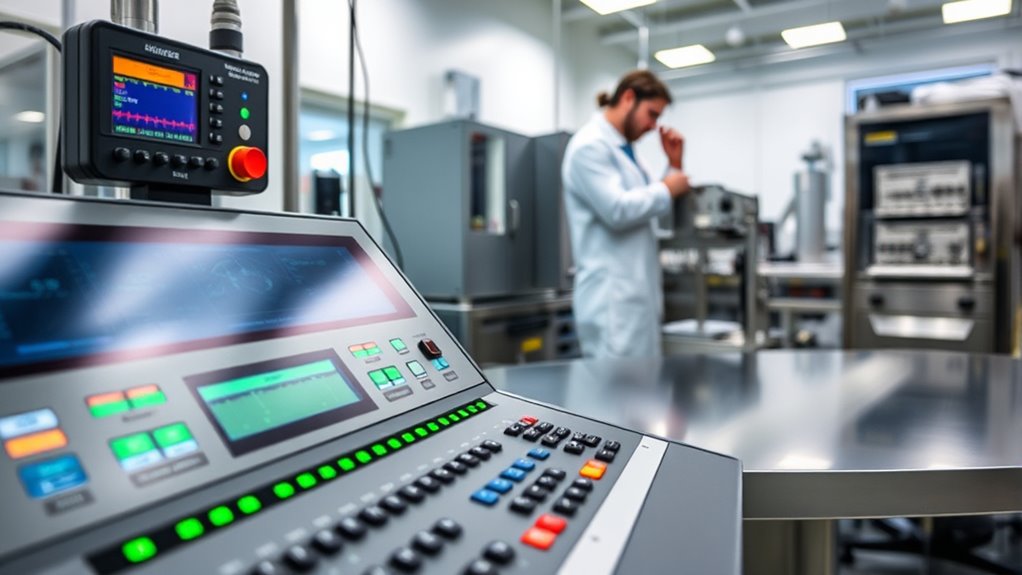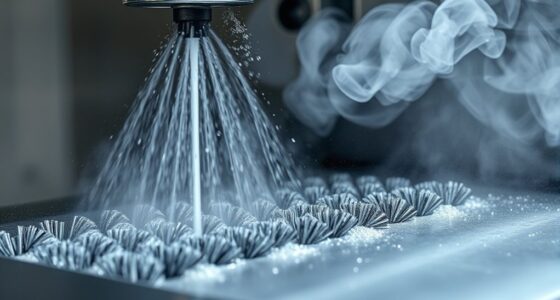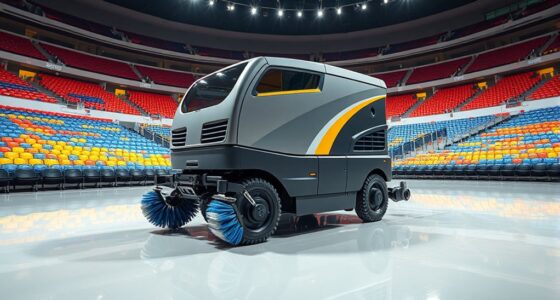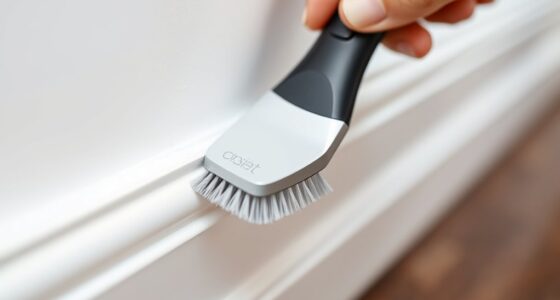To guarantee safety and compliance during specialty cleaning, you need to follow local noise and vibration standards, which set maximum sound levels and limited vibration emissions to protect health and reduce disturbances. Using quieter equipment, soundproofing measures, and vibration dampers can help meet these regulations. Staying within these limits not only prevents penalties but also prolongs equipment life and improves safety. Keep exploring to discover strategies to effectively manage noise and vibration in your operations.
Key Takeaways
- Specialty cleaners must comply with region-specific noise level regulations to prevent health issues and disturbances.
- Use noise reduction techniques like mufflers, soundproof covers, and equipment design to meet permissible sound limits.
- Vibration standards require employing anti-vibration mounts and regular maintenance to prevent equipment damage and safety hazards.
- Adhering to noise and vibration standards helps avoid penalties, reduce costs, and promote a safe cleaning environment.
- Continuous monitoring and technological upgrades are essential for maintaining compliance and improving noise and vibration control.
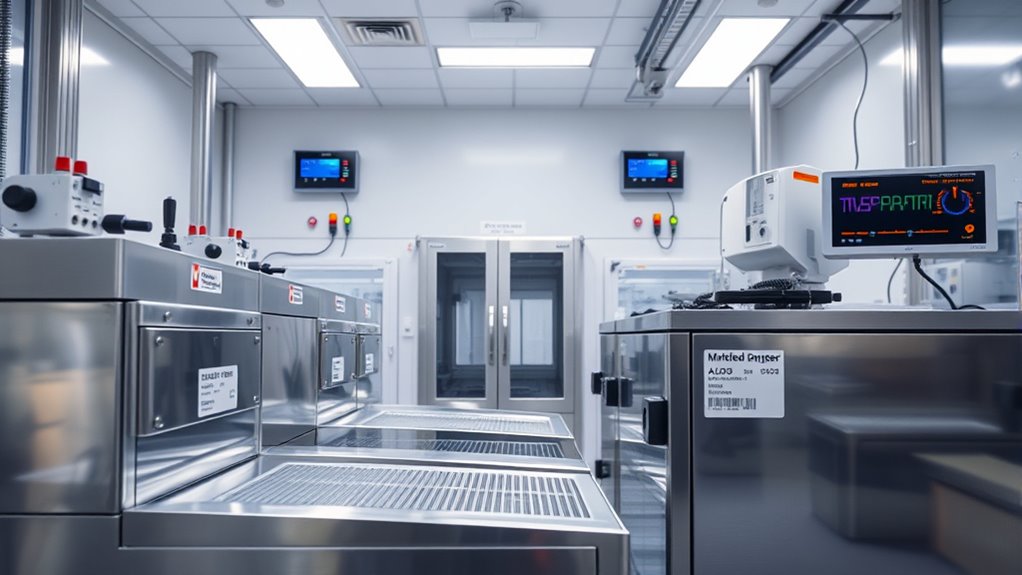
When working with specialty cleaners, understanding noise and vibration standards is essential for maintaining safety and comfort. These standards are put in place to protect workers, clients, and nearby communities from the potential hazards and disturbances caused by equipment operation. Noise regulations set the permissible sound levels during cleaning processes, ensuring that noise doesn’t become a health issue or source of discomfort. These regulations vary by region but typically specify maximum decibel levels for different environments, such as hospitals, industrial facilities, or commercial spaces. Staying within these limits helps prevent hearing loss, reduces stress, and promotes a safer working environment. Vibration mitigation, on the other hand, focuses on controlling and reducing the vibrations produced by cleaning machinery. Excessive vibration can lead to equipment damage, increased wear and tear, and even health problems like hand-arm vibration syndrome for operators. Implementing vibration mitigation strategies—such as using dampers, isolators, or maintenance routines—helps minimize these risks, ensuring equipment longevity and operator safety. Additionally, incorporating sound design principles can help develop quieter machinery and better soundproofing solutions to further reduce noise impact.
You should always familiarize yourself with local noise regulations before starting any cleaning task that involves noisy machinery. This knowledge guides you to select the right equipment, operate it within legal limits, and avoid penalties or shutdowns. For instance, some jurisdictions require noise barriers or enclosures for high-decibel equipment, or they might restrict operating hours to reduce disturbance during nighttime. Alongside compliance, adopting noise reduction techniques—like using mufflers, soundproof covers, or quieter machinery—can greatly decrease noise emissions. These measures not only help you stay compliant but also improve the working environment for everyone involved.
Similarly, addressing vibration concerns is essential for both safety and efficiency. When equipment vibrates excessively, it can lead to increased maintenance costs and potential safety hazards. To mitigate vibrations, you might employ anti-vibration mounts or pads, which absorb shocks and reduce transmission to surrounding structures. Regular maintenance, such as checking for loose components or worn-out bearings, also plays a key role in vibration control. By proactively managing vibration levels, you ensure the machinery operates smoothly, prolong its lifespan, and protect your team from repetitive strain injuries.
In essence, understanding noise regulations and implementing vibration mitigation techniques are fundamental components of responsible specialty cleaning. They help you maintain a safe, comfortable environment while ensuring compliance with legal standards. By paying attention to these standards, you not only protect your team and clients but also enhance the reputation of your cleaning operation. Staying informed about evolving regulations and technological advancements in noise and vibration control allows you to continuously improve your practices, making safety and efficiency a central part of your workflow.
Frequently Asked Questions
How Do Noise Standards Vary Across Different Countries?
You’ll find noise standards differ across countries due to international regulations and cultural differences. Some nations enforce strict limits to protect public health, while others have more relaxed rules reflecting local attitudes towards noise. You need to stay updated on specific regulations in each country, as these standards influence your operations and compliance strategies. Understanding these variations helps you navigate international markets and maintain respectful, lawful practices.
What Are the Health Effects of Prolonged Vibration Exposure?
Prolonged vibration exposure, especially from hand-arm vibration, can lead to serious health effects. You might experience neurological effects like numbness, tingling, or loss of dexterity in your fingers and hands. Over time, it can cause hand-arm vibration syndrome, which affects blood flow and nerve function. These symptoms can worsen if you don’t take steps to reduce vibration exposure, potentially leading to long-term disability.
How Are Noise and Vibration Levels Measured Accurately?
You need to get a handle on how noise and vibration levels are measured accurately—don’t leave it to chance. Start with decibel measurement tools to gauge sound levels precisely, and use vibration calibration devices to guarantee consistent readings. Remember, a little knowledge goes a long way. Properly measuring these factors helps protect your health and meet safety standards, so you’re not flying blind in a noisy or vibrating environment.
Are There Specific Standards for Different Types of Specialty Cleaners?
Yes, there are specific standards for different types of cleaner equipment. You need to follow certification requirements tailored to each specialty cleaner to guarantee safety and compliance. These standards often specify acceptable noise and vibration levels based on the equipment’s design and function. By adhering to these standards, you help protect workers and the environment while maintaining peak performance for each cleaner type.
What Are the Compliance Penalties for Exceeding Standards?
If you exceed noise and vibration standards, compliance enforcement kicks in, and penalty structures are enforced. You might face fines, operational restrictions, or even shutdowns until you meet the required standards. Authorities monitor compliance closely, so it is vital to stay within limits. Penalties aim to ensure safety and reduce disturbances, so taking proactive measures to maintain standards helps you avoid costly penalties and potential legal issues.
Conclusion
By understanding and adhering to noise and vibration standards, you guarantee safety and compliance in your specialty cleaning operations. Staying within these guidelines allows you to keep your work environment safe and efficient. Remember, when it comes to safety, it’s better to be safe than sorry. Don’t let noise and vibration issues become a wolf in sheep’s clothing—address them early, so you’re not caught off guard down the line.
